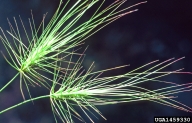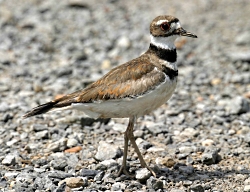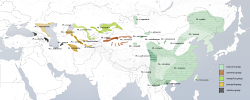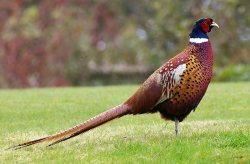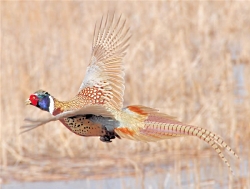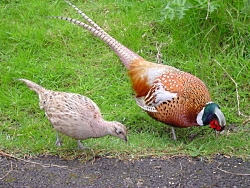
Courtesy & Copyright Anna Bengston
Immortalized on the sets of old western movies, the tumbleweed has long been a classic symbol of the rugged, wide-open landscapes of the American West. As a result, we can all easily recognize the spherical skeletons when we come across them caught on underbrush or piled up on fence lines here in Utah. But this archetype is not an accurate representation of typical western United States or Utah flora, because tumbleweed– or Russian thistle –is an invasive weed.
The story begins in the late 19th century, when South Dakotan farmers reported seeing an unknown plant growing in their croplands. Years later, it was identified as Russian thistle, scientific name Salsola tragus, a native plant of Russia and the Eurasian steppes east of the Ural Mountains. It had been accidentally brought to the United States in a shipment of flaxseed. By the time the U.S. Department of Agriculture published its inquiry into the plant in 1894, about 20 years after the plant’s introduction, 35,000 square miles of land had become “more or less covered” in Russian thistle. Since that time the plant has spread into every state except Florida and Alaska.
So what is the problem? Russian thistle, despite the nostalgic connotations of the old west it inspires, is a pest. It easily takes root in disturbed or bare ground, moving in before native species are able to establish. Drought conditions like those we have had in recent years only promote the plant’s proliferation. The dryness hinders the growth of crops and native species, while the Salsola seed requires very little moisture in order to germinate and grows in where the crops and native species otherwise would have. This can have deleterious effects on cropland and natural ecological functioning. Not to mention the wildfire risk the dry plant debris poses.
Salsola’s sheer numbers have also turned into more than just a nuisance. Each plant may bear some 250,000 seeds that can be spread across miles as they drop off the rolling tumbleweed. Consequently, we see images like those from Colorado earlier this year depicting piles of tumbleweeds filling streets, covering cars, and climbing the walls of houses. In one instance, a windstorm clogged a town in New Mexico with 435 tons of the weed.
Utahns have yet to experience the full effects of this plant’s troublesome nature, but this does not mean we are immune; Russian thistle has been reported in every county of the state. Luckily, for those fighting this plant’s advance, technology and research are on our side. Several biological control options– from insects to fungal pathogens –are being tested as methods of natural Salsola population suppression with encouraging results. But, all in all the management principles have not changed much since 1894: prevent the production and dispersal of seed across all infested areas.
For Wild About Utah, I’m Anna Bengtson.
Credits:
Image: Courtesy and Copyright Anna Bengston
Text: Anna Bengston
Sources & Additional Reading:
Banda, S. (2014, April 9). Tumbleweed troubles: Colorado drought creates perfect storm for road-clogging weeds. . US News. Retrieved May 2, 2014, from https://www.usnews.com/news/us/articles/2014/04/09/colorado-tumbleweeds-overrun-drought-areas
Coffman, K. (2014, March 27). Tumbleweeds plague drought-stricken American West.Reuters. Retrieved May 2, 2014, from https://www.reuters.com/article/2014/03/27/us-usa-tumbleweeds-idUSBREA2Q14E20140327
Dewey, L. (1894). The Russian thistle : its history as a weed in the United States, with an account of the means available for its eradication. U.S. Department of Agriculture, Division of Botany, Washington: Government Printing Office. Retrieved May 2, 2014, from https://archive.org/stream/russianthistleit15dewe#page/n5/mode/2up
EDDMapS. 2014. Early Detection & Distribution Mapping System. The University of Georgia – Center for Invasive Species and Ecosystem Health. Available online at https://www.eddmaps.org/; last accessed May 1, 2014.
Gilman, S. (2014, February 11). Troubleweeds: Russian thistle buries roads and homes in southeastern Colorado. . — High Country News. Retrieved May 2, 2014, from https://www.hcn.org/blogs/goat/troubleweeds-russian-thistle-buries-roads-and-homes-in-southeastern-colorado
Gilman, S. (2014, March 17). A plague of tumbleweeds: A handy pamphlet on how to dig out from a tumbleweed takeover of sci-fi proportions. . — High Country News. Retrieved May 2, 2014, from https://www.hcn.org/issues/46.5/a-plague-of-tumbleweeds
Main, D. (2011, March 2). Consider the tumbleweed. » Scienceline. Retrieved May 2, 2014, from https://scienceline.org/2011/03/virtues-of-a-weed/
Mazza, E. (2014, April 9). Tumbleweeds Reclaim West Amid Drought, Blocking Roads And Canals. The Huffington Post. Retrieved May 2, 2014, from https://www.huffingtonpost.com/2014/04/09/tumbleweeds_n_5115734.html
Ostlind, E. (2011, March 9). Tumbling along. — High Country News. Retrieved May 2, 2014, from https://www.hcn.org/blogs/goat/tumbling-along
Ostlind, E. (2001, May 20). It may be High Noon for tumbleweed. — High Country News. Retrieved May 2, 2014, from https://www.hcn.org/wotr/it-may-be-high-noon-for-tumbleweed
Russian Thistle (Salsola tragus). (n.d.). Russian Thistle (Salsola tragus). Retrieved May 2, 2014, from https://www.blm.gov/ca/st/en/fo/hollister/noxious_weeds/nox_weeds_list/russianthistle.html
USDA, NRCS. 2014. The PLANTS Database (https://plants.usda.gov, 8 May 2014). National Plant Data Team, Greensboro, NC 27401-4901 USA.


